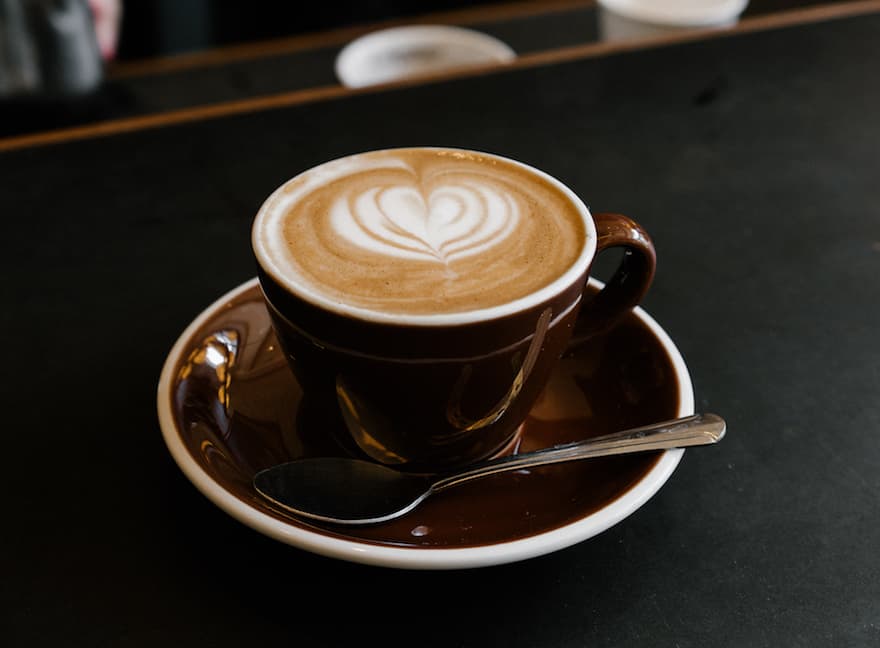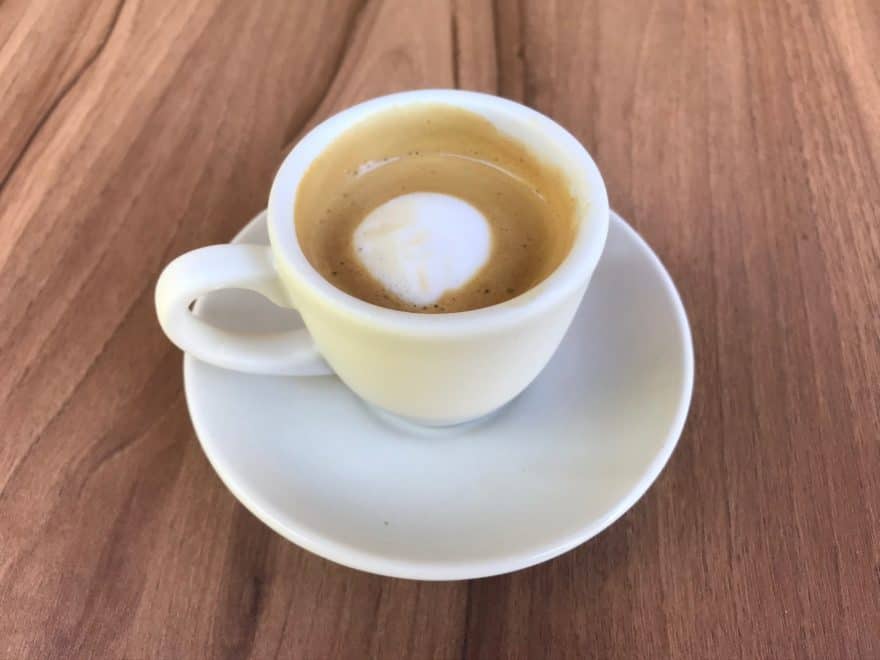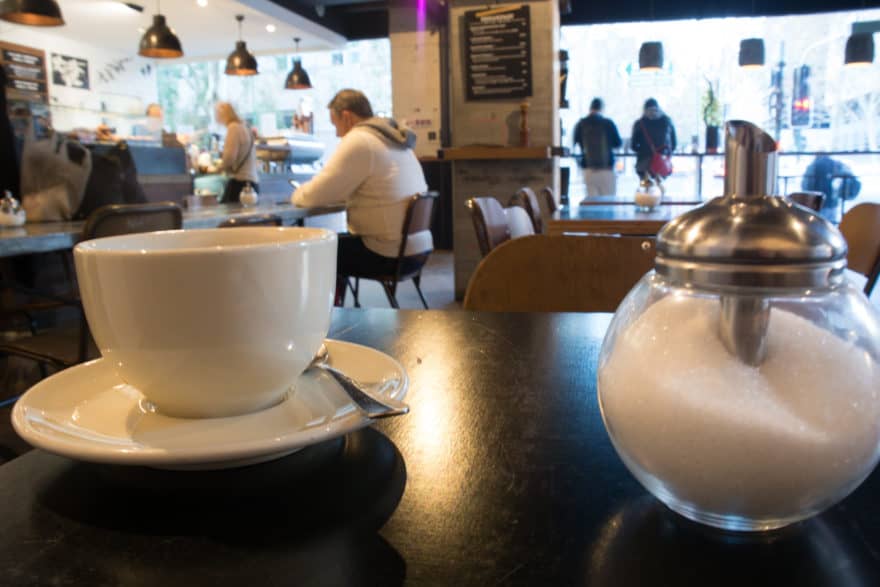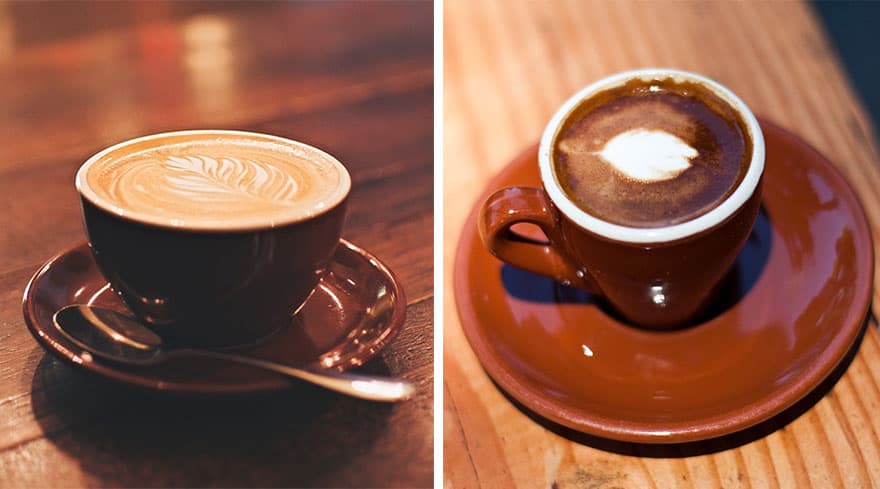Last Updated on November 5, 2023
Some of my toughest decision-making moments have taken place waiting in line at a cafe. If I don’t go prepared, I’ll inevitably find myself internally weighing the pros and cons of a flat white vs. a macchiato.
When it comes to the flat white and the macchiato, each offers a unique experience. Essentially, a flat white is one part espresso to four parts milk, finished with a precise layer of microfoam. A macchiato is two parts espresso to one part milk.
Not only are the methods of constructing these drinks different, but they also have their best time, place and person.
How to make a flat white
You can make a flat white at home if you have a milk frother or an espresso machine with a frothing wand.

A perfect flat white begins with a ristretto espresso shot. This is a shot of espresso pulled using half the usual amount of water, which results in a richer coffee flavour. You can use one or two shots.
- Pull your ristretto shot(s).
- Steam whole milk until it’s 150 F and reaches a creamy, velvety consistency. (We discuss how to create microfoam in our post about latte art.)
- Pour the milk on the top of the shots so that it folds into the drink.
- Serve in a small, tulip-shaped ceramic mug.
For best results, invest in a good espresso grinder and make sure to use cold, fresh milk.
How to make a macchiato
The process of creating an espresso macchiato is quite literally a science. To make a classic macchiato also requires just two components: espresso and milk.

Baristas must steam milk, foam milk and layer with care.
- Brew 1-2 espresso shots and pour into a small glass.
- Steam a couple ounces of milk until the optimal 150 F temperature.
- Froth the milk until it is a sweet foamy consistency.
- Dollop a teaspoon or two over the espresso, as desired.
Depending on how mild you want your macchiato, you can add more steamed milk. Sugar is optional.
Comparing a flat white and a macchiato
It can be difficult to choose between specialty coffee drinks where the ratio of espresso and milk varies. But choosing between a flat white and a macchiato is relatively easy, because they offer a prominent contrast. These two coffee drinks are worlds apart in how they are presented, how they feel, and of course, how they taste.
A traditional macchiato may come in a glass that reveals its layers. Typically, the layer of the espresso is at the bottom, followed by a dollop of foamed milk. Nowadays however, a latte macchiato—the default of coffee shop chains—will begin with milk on the bottom.
The flat white will present more like a cappuccino or latte. In a glass, you’ll see a smooth light caramel blend of milk and espresso, without any real layers except for a shallow surface of milk foam that may or may not include a stylistic design.
Without a doubt, if you enjoy coffee, either of these drinks will suit your fancy. However, the ratio of espresso to milk gives the two a strong contrast. On a spectrum with straight milk at one end and straight espresso at the other, if a flat white falls slightly toward the milk end then a macchiato would fall quite close to the espresso end.

As such, it provides the robust flavor of espresso, softened just a little bit by velvety steamed milk.
The flat white, while stronger than a latte, is certainly less bold in espresso flavor than the macchiato. I like to think of it as a serious latte—and the microfoam fills the taste buds with a sweet creaminess.
History and origins of the flat white coffee
Interestingly, the concept of a flat white emerged not from Italy, but from a coffee shop in Sydney, Australia. In 1985, shop manager Alan Preston created a drink that resembled a latte, except for its characteristic flat film of microfoam on top; hence, the name “flat white.”
Microfoam is simply a dense version of milk froth, whisked until it creates microscopic bubbles.

History and origins of the macchiato
A traditional macchiato itself describes a simple espresso drink that has been “stained” by milk. This original macchiato offered a way to indulge in an espresso, without the intense, full-bodied flavor. Italians commonly drank a macchiato as a way to sneak in espresso mid-day. Usually, it would be served in a small demitasse cup.

This classic is popular in many European countries, while the majority of people in North America are more familiar with the latte macchiato. Starbucks has popularized the latte macchiato, offering it with myriad flavors and add-ins.
Which is better, a flat white or a macchiato?
Choosing between a flat white and a macchiato is a matter of preference. It would be unfair to elevate one over the other. After all, every coffee aficionado has their preferences.
However, each of these drinks has its time and place.
For those just entering the world of espresso, a flat white would be a better choice. It is a softer, milkier drink option than a macchiato.
For people who want the rich hint of concentrated coffee, muted only by a modest amount of milk and foam, a macchiato is your best bet.
I enjoy a macchiato most when I need a strong afternoon pick-me-up. Other times, I choose a flat white when I want to indulge responsibility—we can’t be having a luxuriously sweet latte all the time.
The beauty of espresso drinks is that they always have a place in life. Be it a flat white or a macchiato, anyone can customize and enjoy them however they want.
Which coffee drink will you try on your next cafe excursion?
Images at top: © Neil Conway (left) and VirtualWolf (right) | Creative Commons


